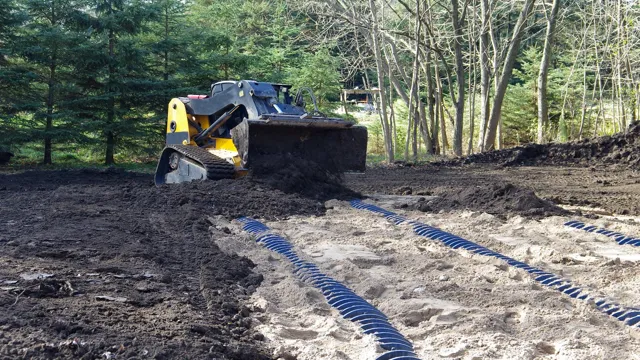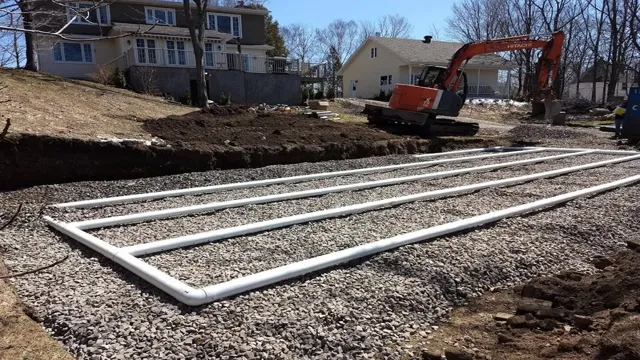Have you ever thought about what lies beneath your yard? For many homeowners, septic systems are a mystery. These underground systems may seem like they are out of sight and out of mind, but they are critical to the functioning of our homes. One component of a septic system that raises questions is the leach field.
This area of the yard is where wastewater from the septic tank is distributed and filtered. But what happens if someone drives or parks on top of it? Can you drive over a leach field without causing damage? In this blog, we will explore the answer to this question and explain why it is essential to protect your leach field.
Understanding Leach Fields
A leach field is a crucial component of a septic system. It is responsible for filtering out impurities and contaminants from wastewater, allowing it to seep back into the ground. However, many people wonder if they can drive over their leach field.
The answer is generally no. Driving over a leach field can cause damage to the pipes and other components, which can result in malfunctioning or even failure of the entire septic system. In addition, heavy vehicles can compress the soil and reduce the effectiveness of the system.
Regular maintenance, such as pumping the septic tank, can help extend the life of the leach field, but it is important to avoid driving or parking vehicles on it to ensure proper function. If you do need to install something over your leach field, such as a driveway, consult a professional septic system contractor to ensure it is done properly and will not harm your system. So, can you drive over a leach field? It’s best to err on the side of caution and avoid doing so to keep your septic system working correctly.
What is a leach field?
Leach fields are an essential component of septic systems. They are also known as drain fields, and their primary function is to clean wastewater that comes from septic tanks. This process involves the seepage and filtration of the treated water into the surrounding soil, where the soil bacteria absorbs any remaining nutrients and impurities.
Leach fields are typically constructed with perforated pipes that are buried in gravel-filled trenches. These pipes distribute the wastewater evenly throughout the field and allow it to percolate into the soil. The soil acts as a natural filtration system, removing any remaining contaminants and bacteria, thus producing clean drinking water.
It’s essential to maintain leach fields properly to ensure they continue to function efficiently. This includes regular inspections, pumping out of septic tanks, and avoiding the use of heavy machinery or planting trees over the area. A well-maintained and correctly functioning leach field is paramount in preventing costly repairs and keeping the environment clean.

How does a leach field work?
A leach field, also known as a septic drain field or leach drain, is an essential part of a septic system that helps to treat and dispose of wastewater. It works by allowing wastewater to slowly percolate through a series of perforated pipes laid in gravel-filled trenches. The surrounding soil acts as a filter, removing harmful bacteria and other contaminants from the effluent before it enters the groundwater or other waterways.
Proper installation, maintenance, and design of leach fields are crucial for their effective functioning. A failed or poorly functioning leach field can lead to the contamination of nearby wells, water bodies, and even cause health hazards. Understanding how a leach field works and taking proper care of it is a crucial part of responsible septic system ownership.
Remember, if you notice any signs of a malfunctioning leach field such as slow drains, foul odors, or standing water, it is best to seek professional help right away to avoid expensive repairs and environmental damage.
Driving Over a Leach Field
Can you drive over a leach field? The answer is no, you should never drive over your leach field. Leach fields, also known as drain fields, play an essential role in the treatment and disposal of wastewater from your septic system. They consist of a network of perforated pipes buried below the surface, which distribute the treated wastewater into the surrounding soil.
Driving heavy vehicles or equipment over the leach field can compact the soil, damage the pipes, and disrupt the drainage system, leading to costly repairs and potential contamination of the groundwater. So, it’s best to avoid driving or parking on your leach field and keep it clear of any heavy loads or construction work. Protecting your leach field is crucial to maintaining a healthy and functioning septic system.
Potential Damage to a Leach Field
A leach field is an essential part of a septic system that filters wastewater before it reaches the groundwater supply. However, it is vulnerable to damage caused by heavy vehicles driving over it. The weight of a car or truck can compact the soil beneath the leach field, making it less effective at filtering water.
Over time, this can lead to clogging and the need for costly repairs. If you need to park or drive over a leach field, it is essential to take precautions to avoid damaging it. One way to do this is to place a layer of boards or other material over the area to distribute the weight.
Additionally, limit the amount of traffic over the leach field as much as possible to prevent long-term damage. Remember, a healthy leach field is critical for protecting the environment and ensuring a safe water supply for your community, so take the necessary steps to protect it.
Factors to Consider Before Driving Over a Leach Field
Before driving over a leach field, there are several key factors that homeowners must consider. First of all, it’s important to understand that leach fields are designed to treat wastewater from your home, and compacting the soil above them can disrupt this process. Additionally, heavy vehicles and equipment can damage the leach field’s pipes and distribution lines, causing clogs, leaks, or other issues.
Therefore, it’s usually best to avoid driving over your leach field whenever possible, and to consider alternate routes for accessing certain parts of your property. If it’s absolutely necessary to drive over the leach field, be sure to take precautions such as spreading out the load by using wide tires, taking turns slowly and carefully, and avoiding concentrated areas or paths that could cause excessive damage. By taking these factors into consideration and avoiding unnecessary vehicular traffic over your leach field, you can help ensure its longevity and continued effectiveness.
Alternative Solutions to Driving Over a Leach Field
Driving over a leach field can cause serious damage to the system, leading to costly repairs. However, there are alternative solutions to consider. One option is to reroute the driveway or parking area away from the leach field.
This may require some landscaping work, but it can prevent future damage to the system. Another option is to install a protective cover over the leach field, such as a geotextile fabric. This allows for some weight-bearing without damaging the system.
Finally, if neither of these options are feasible, it may be necessary to limit the size and weight of vehicles driving over the leach field, or to park them elsewhere. By taking these preventative measures, you can help ensure the long-term health and effectiveness of your septic system while also avoiding costly repairs.
Conclusion
In conclusion, while it may be tempting to use your yard as a shortcut or parking lot, driving over a leach field is not a wise move. Not only can it damage the field and potentially contaminate your groundwater, but it’s also pretty gross to think about driving over a bunch of leeches. So, save your car and your septic system by steering clear of the leach field – your wallet and your conscience will thank you!”
Final Thoughts
Final Thoughts: In conclusion, driving over a leach field can have serious consequences for the septic system and the environment. The leach field is designed to filter and treat wastewater, and any damage to it can cause wastewater to surface and contaminate the surrounding area. It is important to take precautions to prevent damage to the leach field, such as avoiding heavy vehicles and construction machinery on the area.
Additionally, regular maintenance and pump-outs of the septic system can prolong the life of the leach field and prevent costly repairs. Remember, protecting the septic system and the environment should always be a top priority.
Answering the Customer’s Question
Driving over a leach field can cause damage to the septic system, leading to costly repairs. It is imperative to avoid driving heavy vehicles or equipment over the leach field area. The leach field contains a network of underground pipes that are designed to distribute treated wastewater from the septic tank into the soil.
Vehicle traffic can compress the soil, crush the pipes, and damage the distribution system, leading to soil compaction and potential wastewater backups. Homeowners can protect their septic system by restricting traffic over the leach field and ensuring that heavy vehicles such as trucks and tractors stay away from this area. If driving over the leach field is unavoidable, it is essential to take necessary precautions, such as adhering to weight limits and using protective surfacing to prevent damage to the pipes and the surrounding soil.
In conclusion, taking simple steps to protect your leach field can help prevent costly repairs and ensure a properly functioning septic system.
FAQs
What exactly is a leach field?
A leach field, also known as a drain field, is a network of underground pipes or chambers where wastewater from a home’s septic system is dispersed and naturally treated by the soil.
Why is it important not to drive over a leach field?
Driving over a leach field can compact the soil and damage the pipes or chambers, leading to system failure and costly repairs. It can also disrupt the natural treatment process and contaminate groundwater.
How can I prevent damage to my leach field?
It’s best to avoid driving or parking vehicles, heavy equipment, or anything else on or near your leach field. You should also limit the amount of water you use and properly maintain your septic system to avoid overloading the leach field.
What are some signs of leach field damage?
Signs of leach field damage may include slow or backed-up drainage, foul odors, soggy or wet areas on or near the leach field, or sewage backups in the home. It’s important to have your system inspected regularly to catch potential problems early.
Can I plant trees or shrubs on or near my leach field?
In general, it’s not recommended to plant any trees or shrubs on or within 10 feet of a leach field. The roots can infiltrate the pipes or chambers and cause damage to the system. Instead, stick to grasses or other low-rooted vegetation.
Should I add septic tank additives to my system to help my leach field?
It’s not necessary to add septic tank additives to your system, and some products can actually harm the natural treatment process in your leach field. Proper maintenance, including regular pumping, is the best way to ensure your system is working efficiently.
How long does a leach field last?
The lifespan of a leach field can vary depending on factors such as system design, soil type, and maintenance. With proper care and maintenance, a leach field can last anywhere from 25 to 50 years or more.






